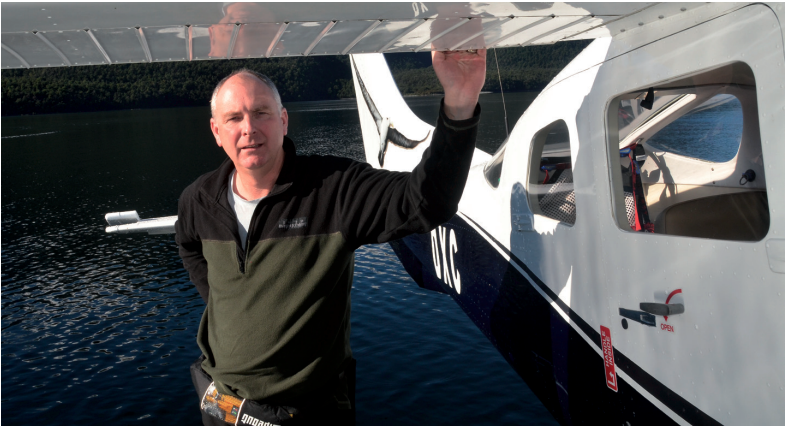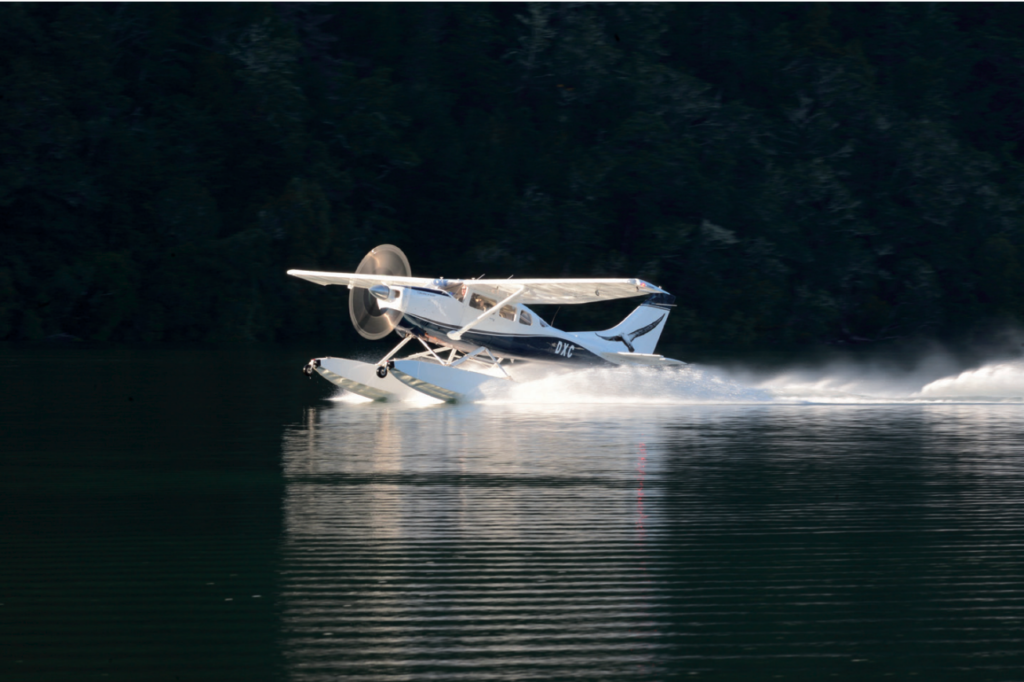By Ross Millichamp
These aircraft have a hard life due to the stresses of taking off, landing and being moored on rough water, and from the corrosion that comes from continued exposure to fresh and salt water spray. By 2014 DXC had done 9000hr of toil in this hostile environment and had come to the end of its economic life. The uncertainty around cost and the time out of the air involved in the looming SIDS process were the deal breakers. DXC was disassembled and pushed to the corner of the hangar from where Mike Scotter bought it for little more than the value of the engine core that accompanied it.

Mike is currently an A320 Captain with Air New Zealand, but has the right pedigree to take on a project of this scale. Son of well-known retired airline pilot and aircraft engineer Pat Scotter, Mike also holds a LAME certificate and had a solid background in GA flying before moving to the airlines.
The re-birth of DXC took six years. Looking at the before and after pictures it’s hard to believe it’s the same aircraft.
In addition to much needed work on the airframe, DXC received new paint, a new interior, a new Continental IO-550N engine, a clever MT prop that can be put into reverse pitch to allow braking, a second front door on the passenger side and a set of Aerocet ‘amphibious’ floats in place of the straight ‘water-only’ floats of the past.
Mike acknowledges the contributions from his father Pat, Byron Phillips, Malcolm Price and Arnold Gallagher in particular.
Initially DXC went back onto wheels while the engine was run in and the rigging set up and trimmed. Then it was back to school for Mike as Ivan Krippner and Simon Nicholson taught him the art of flying on floats.
I first met Mike back when DXC was a work in progress, and wondered about the utility of an aircraft primarily set up for water operations, however the addition of wheels that retract in and out of the floats make this a surprisingly useful aircraft on land also. Mike has had DXC into back country strips such as Manuka Point and Gorge River, which are short, bumpy and narrow. The wheels are quite different from those we are familiar with – there are four of them for a start! The rear main wheels are fixed, as is the norm, but the front wheels castor like a very old-fashioned tailwheel plane. Most significantly, there is no steering on the nose wheels. Directional control on the ground is from the rudder and brakes, kind of like a tailwheel in reverse.
DXC always looked big in the Rangiora Aircraft Engineering hangar but looks enormous out in the open. Sitting in the passenger’s seat everything on the inside looked familiar to me, with the exception of a depth gauge in the panel. Look outside, though, and we seemed to be terribly high off the ground, and because you can’t see the wheels from the front seats, it just seemed wrong to be moving smoothly across the land on floats.
We took off from the grass at Rangiora and were airborne in 200m at most. Admittedly, with two POB and half tanks we were light, but I was reminded that a big engine and prop overcome pretty much everything else in a Cessna when it comes to take-off performance. Once airborne the drag effects of the floats start to come into play. Mike can get 120kts indicated airspeed out of DXC but it comes at the expense of a lot of fuel and a much restricted range, so he chooses to operate well lean of peak at 105kts and around 42 l/hr.
We cruised through the North Canterbury foothills for twenty minutes before arriving overhead Lake Sumner, Mike’s closest water playground. At this point I asked about the legalities of landing on water in New Zealand, where floatplanes, amphibians and seaplanes are a rarity. It turns out that the rules are set by the maritime authorities, in this case Environment Canterbury, and allow Mike plenty of scope to do his thing. I did think it a bit odd that the planners around New Zealand had spent so much time writing rules for such a small activity though. I guess it harks back to the days before helicopters when floatplanes filled a vital role in back country access.
Lake Sumner is the biggest lake in North Canterbury and is aligned beautifully with the prevailing winds. We arrived overhead in perfect conditions – the wind was light and the lake smooth with just a few ripples. ‘Just a few ripples’ allows you to see where the lake ends and the sky starts, which is critical to making a safe landing. When climbing into DXC earlier, I’d been puzzled about the purpose of a small bag of pebbles sitting within reach of the pilot’s seat. Mike explained that in completely calm conditions you drop a few pebbles out the window onto your chosen landing spot then zoom back around and land on the ripples created.
Mike set us up for landing and explained that it’s all about aircraft attitude. It’s rare that you need to ‘hit the spot’, as is the case when landing a wheeled plane on a short strip. There are two schools of thought about the perfect touchdown. One is to touch down in a slightly nose high attitude, so that the heels of the floats touch first, to slow the aircraft as it settles onto the floats. The other is to touch down flat on the floats. Both approaches involve a very gentle rate of descent while carrying a little power. Everyone agrees that you do not want to touch down on the front of the floats, as it is then difficult to retain directional control. To a novice the difference between nose high, nose level and nose low was very subtle and nothing like the attitudes used in a typical wheeled aircraft landing.

Once on the water Mike taxied into the shore and dropped me off to take a few pictures. DXC looks and sounds even more impressive from the shore, with plumes of spray flying out the back and the noise of that magnificent IO-550N reflecting off the water and the surrounding hills.
Mike returned and very generously offered me a turn behind the controls. He pulled a cord on the cockpit floor to stow the water rudders and got me to practice a few water turns as we moved out into the lake. It turns out that both boating and flying skills are part of the floatplane deal. Once in position he talked me through the take off – full power, control column fully aft and a heap of right rubber to keep it straight. “You might run out of rudder at the start but it will come right as the speed builds,” he said. “At 23-24kts it will pop onto the step (‘onto the plane’ in boat speak) and you need to ease forward into a neutral attitude and allow the speed to build.”
I found the initial stage of the take-off quite disorientating due to the extreme nose high attitude, and had to check direction by looking out to the side rather than ahead. Once on the step, though, it was just a matter of sitting back and waiting for the speed to build before giving the controls a very gentle pull to pop the aircraft into the air. The landings were like going back to initial flight training where, after getting everything set up, you must look well ahead and wait for the runway to come to you. Except in this aircraft, the touchdown always comes sooner than you think due the height of your seat above the water. Sideways drift on landing is a no-no as when the keels of the floats bite the water, any sideways movement gets interesting. One unusual element of the landing was the electronic voice coming from the gear system telling you that you were about to do a “water landing”. Herein lies one of the potential issues with amphibian aircraft: it is actually okay to land on grass with the wheels up, but definitely not okay to land on water with the wheels down.
Now that the hard work has been done, Mike is using DXC for all sorts of adventures. A typical trip to Fiordland or Stewart Island involves heading south as soon as the weather clears after a front, and enjoying two to three nights away before the next front arrives. The ideal situation is to arrive at high tide and tie the aircraft to a tree to be left high and dry as the tide recedes. On occasions Mike lowers the wheels before shutting down and is able to taxi back to the water’s edge on departure if the terrain allows. There are plenty of huts scattered around the fjords and on Stewart Island to use as a base to explore with the inflatable dinghy he carries. With the big clam-shell back door, the 206 is a great transporter of gear and equipment. Mike is currently helping Andrew Bowmar to build a hut at Port Pegasus at the south-eastern end of Stewart Island. By removing the back seats he can fit 3.6m lengths of timber into the cabin.
ZK DXC is a unique aircraft in New Zealand. It is pleasing to see it, after six years of hard work and expense, being well used by Mike and his family for amazing adventures in the New Zealand wilderness.

This article first appeared in the Spring 2021 edition of Approach Magazine, the dedicated magazine of AOPA NZ, which is published quarterly.

